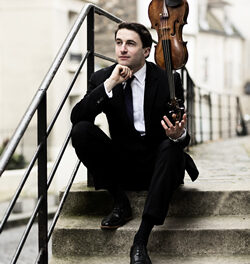Esencia. Ed Stephenson, guitar, with Iños Flamenca: Craig Hilton, guitar, Ryan Johnson, bass, Sara Ramweber, percussion, Pee Wee Watson, bass, Teresa Fernandez, vocals, & Rodney Marsh, flute. Liscio Recordings, Inc. LCD-00731 © 2011, PO Box 248, Wilmington, NC 28402 (910-452-5323); ten tracks – six with ensemble and four solo; TT 40.5 minutes, available as download via iTunes and from the artist’s web site as a CD.
This program is a mix of flamenco-pop and quasi affettuoso classical guitar, all bearing down heavily on the improvisational side of Spanish music. The first six tracks are basically of the flamenco-pop or nuevo flamenco genre – a hybrid or fusion with other styles of music. It has all the characteristics and virtuosity of traditional flamenco guitar but falls outside – or perhaps expands upon – the limited traditional flamenco harmonies and structure. You find influences such as bossa nova or Latin, rock, jazz, swing and salsa, and others.
Here the instrumentation is critically enhanced using traditional castanets, hand clapping, and high and low percussion to punctuate the duende. The recording is nicely produced, mixed and edited. The ensemble is tight with rhythmically biting and often infectious enthusiasm. Typical signature flamenco characteristics include scalar bursts, tremolo, and percussive golpe on the instrument’s soundboard. Of course it is easy to hear the all important emotional ethereal dreamy wandering a’plenty.
Raleigh-based Ed Stephenson is a native of Toronto, Canada, who directs the Guitar Studies program at Meredith College. He began his undergraduate studies at the Peabody Conservatory, and completed his formal academic degree at the University of North Carolina School of the Arts. He is a member of the North Carolina Guitar Quartet and the Paco Band – later is at times a mirror image of Iños Flamenca. His work calendar reflects a mix of classical performances, club and restaurant dates, house concerts and weddings. This kind of reality for contemporary musicians indicates flexibility and varied repertoire.
Stephenson told me the title; Esencia, is Spanish for essence and here refers to “the primary emotional character of each of the pieces. The CD as a whole is a representation of what the ensemble wants to convey in performance. Our music is all Spanish in origin (or influence, for the pieces we write ourselves).” The title track borders on American light folk-rock. It uses a long introduction with a repeating two chord progression which then serves as foundation for guitar improvisation over the top, in flamenco style. A tempo change mid way opens up a slightly different harmonic sequence and then returns to the original figure. Another track, “Del Mar” (The Sea), presents a lilting waltz with a change to cut-time mid way and certainly was conceived to be danced at sunset with a pitcher of margaritas nearby.
Some track titles are nearly autobiographical: “Woo” uses ostinato with cross-string intervals of the second, a haunting descant flute, and primary solo guitar. It was named after a favorite cat that died a few years ago. “Ino” is harmonically adventurous and presents a broader pallet of ideas including an opening percussion rhythm. It is the name of a Spanish chef and friend who owns a restaurant in Toronto.
The solos are duende-imbued renditions of standard classical guitar repertoire that are surprisingly effective and that refresh their signature elements. “Cancion del Emperador” by vihuelist Luys de Narvaez (fl.1526-49) is based on a theme by Josquin des Prez (c.1450/1455-1521) and is first distinguished by use of a capo on the third fret, thus raising the pitch a minor third. This common practice emulates the standard of tuning thought to exist 500 years ago. Also, the scale figures are brisk in the middle but kept in overall time, reflecting a human sensibility over scholastic dogma. The performance is as clean and welcome as any I’ve heard.
An interesting reading of “Asturias” by Isaac Albeniz is based on the piano score and employs use of the golpe in the middle (Adagio) section. Pressure is kept up on tempo, and the coda has an improvised tremolo. It is generally well played and mirrors strong character throughout.
Gaspar Sanz’s “Canarios” is a multi-tracked version performing the first iteration as the original baroque guitar solo; the second adds harmonic chords blocked in place, and the third adds percussion and more prominent bass. Thereafter it takes on its own life.
There is a vocal setting of the well-known solo guitar piece “Romance” by Anonymous, natch, that brings a fresh image to this heavily-abused theme. It is played a half step higher than normal, up to F, and recalls the lover’s quandary through the ages. Again this version is well done, though I had trouble adapting to the voice after so many instrumental tracks.
The packaging of this CD is excellent, but there are no notes about the music or titles, there are no bios of ensemble members, and the program seems a tick short at forty minutes. Yet there is still much to offer here, and the program and performances remind the listener that there are humans at work evoking eons of spirit and passion.











